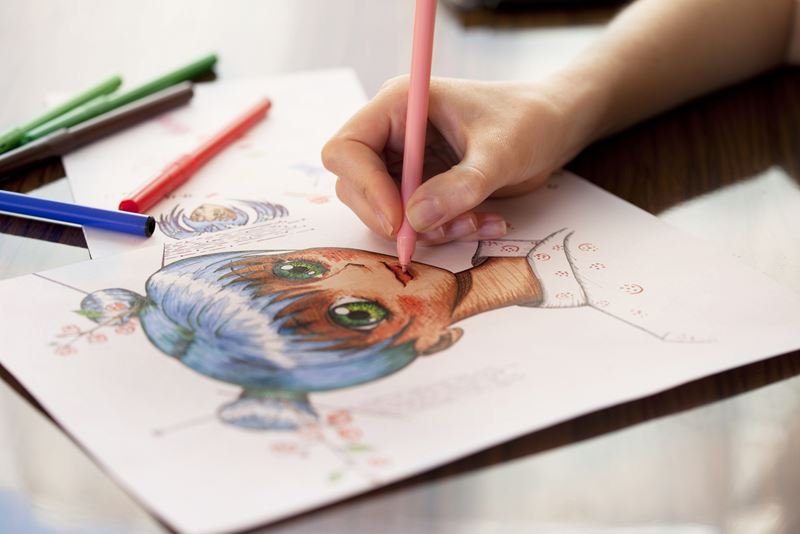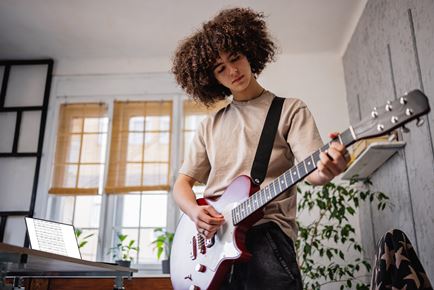
It’s the final week of the spring semester at the Ozanam Campus. In the expressive therapy sessions, therapists and youth are straddling between finishing projects before the semester ends and making plans for the summer.
Several youth are working diligently to complete art, music, and movement therapy projects, some of them weeks in the making. It’s all part of the process of learning and growing through art.
Expressive therapy combines principles of psychology and the benefits of the creative process to promote emotional growth and healing. The expressive therapists at the Ozanam Campus provide at least one session each week to the 42 youth that live on campus. It is creative, but it’s more than just play. As with any other therapy, it is a way to provide trauma-informed care.
“We provide experiential, process-focused therapy,” said Janna Cochran, Program Manager of Expressive Therapies and Substance Use. “A final product is not our goal; rather, it’s the personal growth that can come from engaging in something novel and sometimes difficult.”
Exploration and Patience Through Art Therapy
Three teenage boys work on projects in the art studio. One is designing on a computer, another is finishing a bead project of a Japanese anime figure, and the third is painting three clay pottery projects to be fired in the kiln. All of this is done under the supervision and support of Taylor Croan, the Art Therapist at the Ozanam Campus.
“The art itself is the therapy,” said Taylor. “All of these projects have encouraged the youth to sustain attention and develop their frustration tolerance.”
As the youth work on their projects, they decide which TV episodes of Japanese anime they will have on in the background. Both Taylor and the youth are knowledgeable about anime, and an informed discussion occurs about what to watch on the final day of therapy.
After some discussion, an episode about a young anime character Naruto is selected. Anime remains popular among young people and is relatable through its coming-of-age themes. Naruto has a particularly prescient storyline. Due to an incident at birth, Naruto faces misperceptions over something that is no fault of his own, which is something many young people in foster care will understand.
All three boys work at a rapid pace. One pulls beads from a gallon jar to find the right colors and fix them to his project with tweezers; another selects paint colors to add quick coats to the three clay pieces. Meanwhile, Taylor asks questions about summer plans and how sessions will change when the school year ends.
“We’ve chunked out these projects over several weeks to help them understand delayed gratification,” said Taylor. “We worked toward creating something they can feel good about and take home.”
In some settings, expressive therapy is more effective than more traditional forms of talk therapy. It’s also a growing part of trauma-informed care on campus. New this year, the therapists serve an additional 30 students from the Ozanam Campus and Gillis Campus Day Schools and youth in transitional living at the Missouri Pathways House with substance use prevention and treatment.
In that program, the therapists alternate between art, music, and movement therapies to teach students about the dangers of substance use and how to cope with societal pressures to use drugs. This program is funded through Cornerstones of Care’s COMBAT grant, a Jackson County tax for substance use and violence prevention.
Finding Boundaries Through Movement Therapy
Movement Therapist Caroline Hale leads two young girls into a room with a large open space. The girls begin the session by sharing their feelings, each giving the intensity of their emotion a numeric value and marking it on a whiteboard.
Caroline encourages the girls to find creative ways to move around the room with spins, leg kicks, waving arms, and skipping. They walk on their heels, then on their toes. Caroline tells them to move and then “freeze,” holding their positions. These activities focus on helping the girls understand spatial boundaries and express their emotions using their bodies.
“Movement is everyone’s first language as we grow,” said Caroline. “Kids go through phases of growth that are connected to different development. If they don’t go through those phases, it’s hard for them to learn.”
As the movement winds down, Caroline leads a discussion about appropriate techniques to ask people to stop behaving in ways that make them uncomfortable. The conversation then moves to reading facial expressions to determine the unspoken agreement two people have when interacting in the same space.
Caroline ends the session by introducing small plastic spiked balls used for foot massages. The girls were first concerned that the soft spikes might be more painful than relaxing but soon found rolling the balls on their arches and heels was restorative.
“I want to end the session with grounding and going back to the feet,” Carolina said. “This helps them to leave the experience behind.”
Caroline has helped expand movement therapy on the Ozanam Campus since she arrived in 2021. Through a grant, the team transformed an unused tennis court on campus into a colorful playground, which helps the residential youth learn through play. They learn how to adjust to new circumstances, including how to balance, ride scooters, jump rope, and get up after falling.
Producing a Song One Layer at a Time
Music Therapist Kailey Campbell enters the music studio with *Tom, a member of the music ensemble, to finish a recording project. The ensemble, which currently includes Tom and *Mark, a bass player, is finishing a recording of the song “Riptide” by Vance Joy. Tom starts the session by playing guitar and singing their version of Harry Styles’ “As It Was.”
 The ensemble group has been a consistent part of the Ozanam Campus’s Music Therapy program for several years. Membership changes regularly as youth are discharged or become interested in another form of expressive therapy. Tom and Mark were part of the ensemble that won “Ozanam’s Got Talent!” winter talent show last December.
The ensemble group has been a consistent part of the Ozanam Campus’s Music Therapy program for several years. Membership changes regularly as youth are discharged or become interested in another form of expressive therapy. Tom and Mark were part of the ensemble that won “Ozanam’s Got Talent!” winter talent show last December.
“Some of our youth conquered big hurdles that day in terms of managing stress and anxiety in front of a crowd, recovering from mistakes, and engaging safely with peers and staff,” said Kailey. “The responses from the youths’ therapists, case managers, family, and other supportive people were gratifying to see.”
Tom takes an acoustic guitar from the rack, puts on headphones over his ball cap, and steps to the microphone. After a couple of practice takes and a few technical adjustments, he plays through the rhythm guitar part of “As It Was.” He’s playing to a track in the headphones, so only his guitar strumming is audible outside the recording.
Earlier in the semester, Kailey encouraged collaboration among the youth by asking the ensemble what songs they would like to learn. The group selected the songs based on their taste and to broaden their musical styles.
“The youth in Music Therapy make choices about how they engage with the therapy, in terms of what instruments they play and the songs they sing,” said Kailey. “This freedom and autonomy is a valuable source of control and agency they may lack in other areas of life.”
After Tom finishes recording, Mark* records the bass track for “Riptide.” Tom and Mark add the final layers to their recording with a relaxed focus, which may be a product of the semester of music therapy. Music therapy often leads to improved emotional management, development of healthy coping strategies, and stronger interpersonal communications among participants, said Kailey.
Everyone in the room stops to listen to the recordings from start to finish and agrees that both songs sound pretty good. The personal growth experienced by completing the project is ‘pretty good,’ too.
*Names are changed to protect privacy


